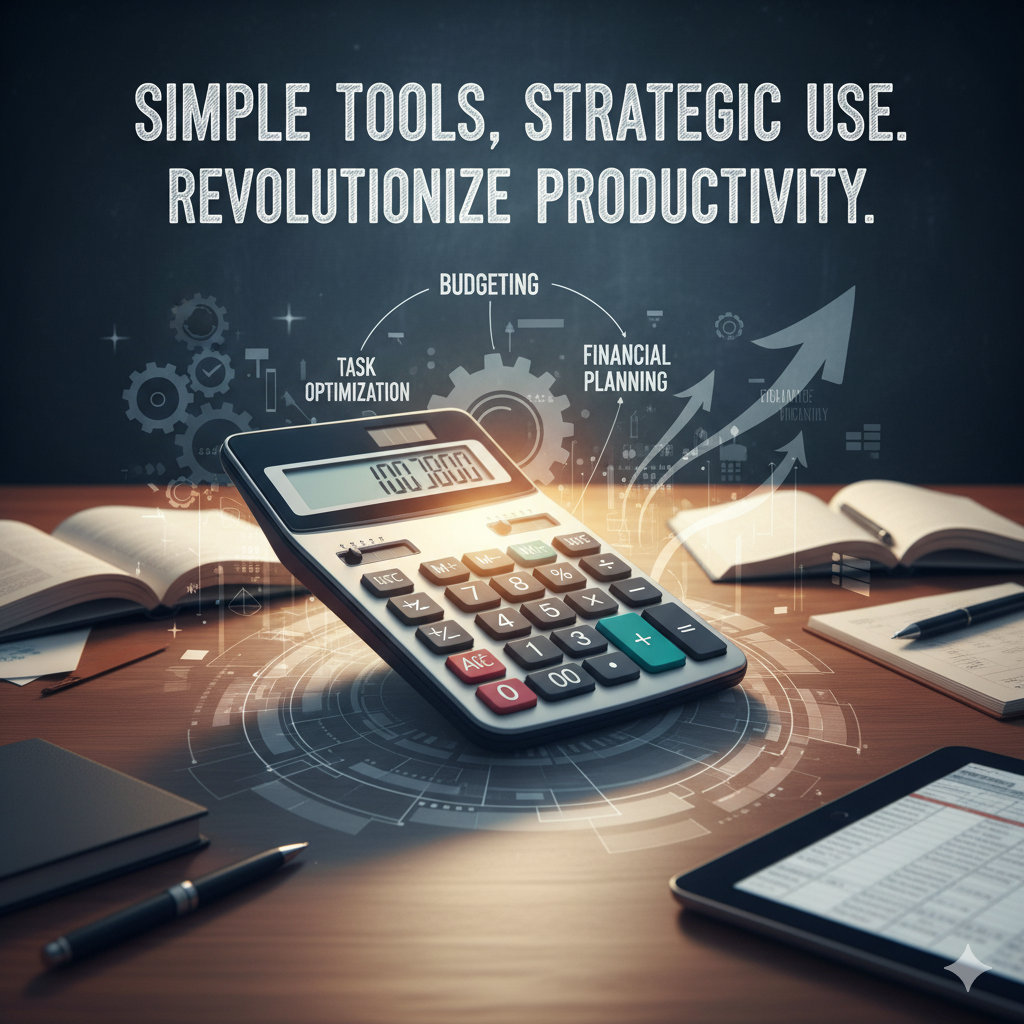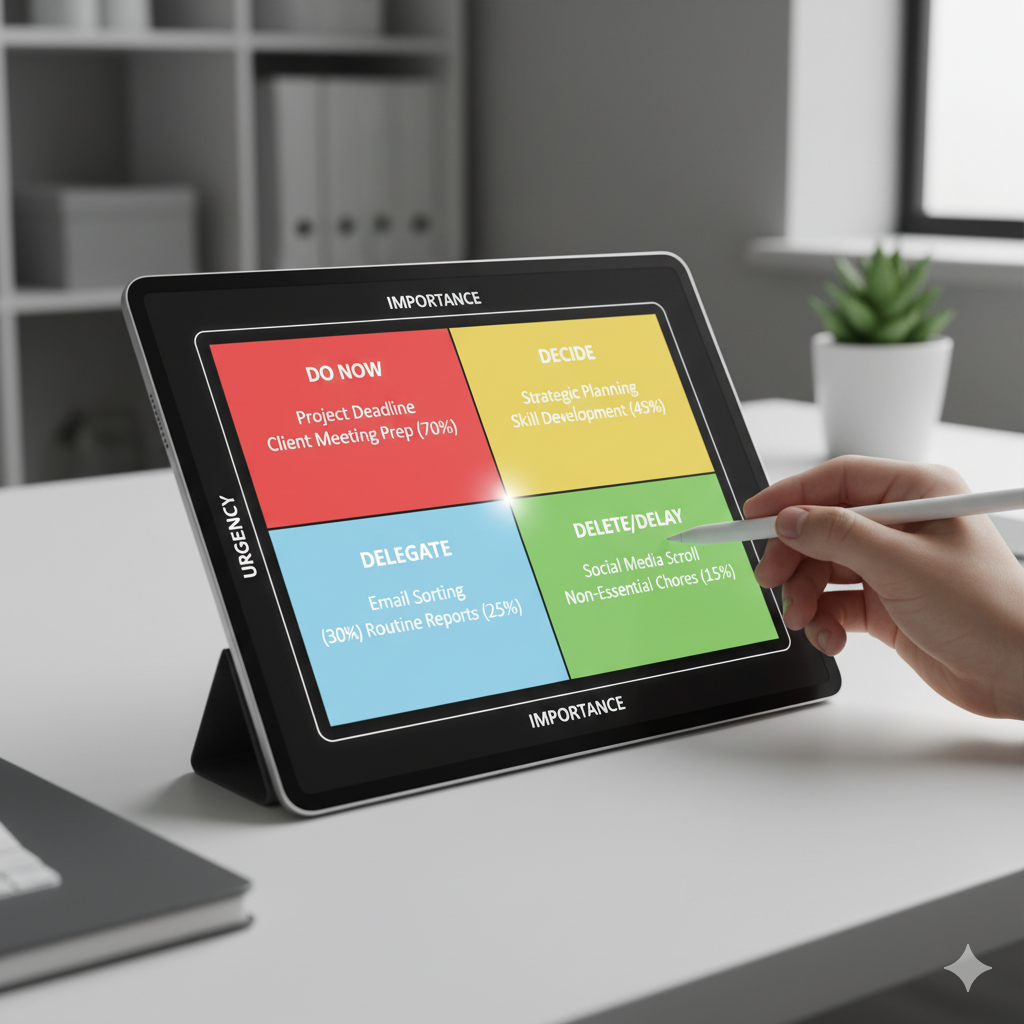In our constantly connected, always-on world, productivity has become both a prized asset and an elusive goal. We're all searching for that magical formula that will help us accomplish more in less time, with less stress. What if I told you that some of the most powerful productivity tools are hiding in plain sight—tools you've likely been using since elementary school?

Calculators, those humble number-crunching devices, can be transformed into powerful productivity engines when used creatively. At Proculator, we've discovered innovative ways to leverage calculator functions that go far beyond basic arithmetic. These techniques have helped thousands of users reclaim hours in their week, reduce decision fatigue, and optimize their energy for peak performance.
In this comprehensive guide, we'll explore 10 calculator hacks that will revolutionize how you approach your daily tasks, manage your time, and maximize your productivity potential.
1The Time Value Calculator: Quantifying Your Most Precious Resource
Time is our most limited resource, yet many of us spend it as if it were infinite. The first step toward true productivity is understanding the actual value of your time. This isn't about putting a dollar amount on every minute—it's about developing a mindset of intentional time allocation.

How to Calculate Your Time Value
Start by determining your effective hourly rate. If you're salaried, take your annual income and divide it by 2,080 (52 weeks × 40 hours). If you're hourly, use your current rate. Now, consider that this represents your professional time value, but your personal time has value too—often even more than your professional rate.
Next, use our Time Calculator to track how you're currently spending your hours. For one week, log your activities in 30-minute increments. Be brutally honest—this isn't about judgment, it's about awareness.
Applying Time Value to Daily Decisions
Once you know your time value, you can make smarter decisions about outsourcing, task prioritization, and opportunity cost. For example:
- If your time is worth $50/hour, does it make sense to spend 3 hours cleaning your home when a cleaning service charges $35/hour?
- If you spend 30 minutes daily searching for misplaced items, what is the annual cost of disorganization?
- How much time do you lose to context switching between tasks?
Pro Tip: Use the Compound Interest Calculator to calculate the long-term impact of time savings. Saving just 30 minutes per day adds up to 182.5 hours per year—that's over 4 full work weeks!
By quantifying your time, you shift from being reactive to intentional with how you spend your most limited resource. This single mindset change can yield the most significant productivity improvements of any hack in this guide.

2The Priority Matrix Calculator: Eisenhower Decision Matrix
Not all tasks are created equal. The Eisenhower Matrix, popularized by Stephen Covey in "The 7 Habits of Highly Effective People," helps categorize tasks based on urgency and importance. While traditionally represented as a 2×2 grid, we can enhance this system with mathematical precision.

Creating Your Priority Scoring System
Assign numerical values to your tasks based on these criteria:
| Factor | Weight | Score Range |
|---|---|---|
| Urgency | 40% | 1-10 (10 = most urgent) |
| Importance | 30% | 1-10 (10 = most important) |
| Effort Required | 20% | 1-10 (10 = most effort) |
| Impact | 10% | 1-10 (10 = highest impact) |
Using a simple weighted average formula, calculate a priority score for each task:
Priority Score = (Urgency × 0.4) + (Importance × 0.3) + (Effort × 0.2) + (Impact × 0.1)
Our Grade Calculator can be repurposed to handle these weighted calculations efficiently.
Implementing Your Priority System
Once you've scored your tasks, sort them from highest to lowest priority. This eliminates decision fatigue about what to work on next—you simply tackle the highest-scoring task available.
Success Story: Mark, a project manager, reported a 32% increase in meaningful task completion after implementing this scoring system. He found that he was consistently working on high-impact activities rather than just responding to urgent demands.
Remember to recalculate scores as circumstances change. A task that wasn't urgent yesterday might become critical today.

3The Energy Optimization Calculator: Work With Your Natural Rhythms
Productivity isn't just about managing time—it's about managing energy. We all have natural energy fluctuations throughout the day, and working against these rhythms is like swimming upstream.

How to Calculate Your Energy Patterns
For one week, track your energy levels on a scale of 1-10 every hour. Note what activities you're doing and how focused you feel. Use our Percentage Calculator to identify patterns:
- What percentage of your high-energy time (8-10 rating) are you spending on low-value tasks?
- During what hours do you consistently have the highest energy?
- What activities drain your energy fastest?
Creating Your Energy-Optimized Schedule
Once you identify your energy patterns, restructure your day:
- Schedule demanding, creative work during your peak energy hours
- Place routine, low-cognitive tasks during your energy lulls
- Build in recovery breaks before energy crashes occur
Pro Tip: Calculate your "focus ratio" by dividing your high-focus hours by your total working hours. Aim to increase this ratio by eliminating distractions during peak energy times.
Research shows that working with your natural energy rhythms can increase productivity by up to 30% while reducing mental fatigue.
4The Meeting Cost Calculator: Quantifying the True Price of Gatherings
Meetings are one of the biggest productivity drains in modern workplaces. The true cost of a meeting isn't just the duration—it's the combined hourly rates of all attendees plus the "context switching tax" of moving in and out of deep work.
How to Calculate Meeting Costs
Use this formula to calculate the true cost of any meeting:
Meeting Cost = (Duration in hours × Number of attendees × Average hourly rate) + (Number of attendees × 15 minutes × Hourly rate × 2 [context switching penalty])
Our ROI Calculator can help you determine if a meeting's potential outcomes justify its cost.
Implementing Meeting Cost Awareness
Once you start calculating meeting costs:
- You'll naturally question whether each meeting is necessary
- You'll be more likely to insist on clear agendas and outcomes
- You'll consider alternatives like async updates or quick stand-ups
Case Study: A tech company reduced meeting time by 40% after implementing meeting cost calculations, resulting in an estimated $2.3M annual savings in recovered productivity.
Remember: The most productive meeting is often the one that doesn't happen.

5The Task Batching Calculator: Minimizing Context Switching
Context switching—moving between different types of tasks—can cost as much as 40% of your productive time. Task batching groups similar activities together to minimize these mental switching costs.
How to Calculate Your Context Switching Cost
Track how many times you switch between different types of tasks in a day. Research suggests it takes an average of 23 minutes to fully regain focus after a context switch. Calculate your daily context switching cost:
Daily Switching Cost = Number of context switches × 23 minutes × (Your hourly rate / 60)
Optimizing Your Batch Schedule
Use our Time Calculator to:
- Group similar tasks (emails, calls, creative work, administrative tasks)
- Schedule batches during appropriate energy levels
- Set specific time limits for each batch
Pro Tip: Calculate the ideal batch size by tracking how long you can maintain focus on a particular task type before quality declines. Most people optimize batches at 60-90 minutes.
Effective batching can recover 2-3 hours of productive time per week for the average knowledge worker.
Implementing Your Productivity System
Knowing these calculator hacks is one thing—implementing them consistently is another. Here's how to build your personalized productivity system:
Start Small
Choose one or two hacks that address your biggest pain points. Implement them for 21 days to establish habits before adding more.
Measure What Matters
Use our Standard Deviation Calculator to identify your most variable productivity patterns—these are often the best areas for improvement.
Review Weekly
Schedule a weekly review to assess your system, calculate your productivity metrics, and make adjustments. Continuous improvement is the goal.
Final Thought: Productivity isn't about doing more—it's about doing more of what matters. These calculator hacks are tools to help you focus your limited time and energy on high-impact activities that align with your goals and values.
Ready to Transform Your Productivity?
Explore our suite of calculators designed to help you work smarter, not harder.
Discover All CalculatorsFrequently Asked Questions About Productivity Calculators
How accurate are these productivity calculations?
These calculations provide estimates based on general principles and averages. Your individual results may vary based on your specific circumstances, but the formulas offer valuable frameworks for thinking about productivity quantitatively.
Won't all this calculating itself become a productivity drain?
Initially, there is a small time investment to set up these systems. However, the long-term time savings far outweigh the setup costs. Most of these calculations need only occasional updating once established.
How often should I recalculate my productivity metrics?
Most metrics should be reviewed quarterly, though some (like task priority scores) may need daily adjustment. Energy patterns should be reassessed seasonally, as they can change with daylight and lifestyle shifts.
Can these techniques work for teams, not just individuals?
Absolutely! These calculator hacks can be scaled for team productivity. The meeting cost calculator and distraction cost calculator are particularly valuable for team optimization.
What if I'm not good with numbers? Can I still benefit?
Yes! The calculators do the math for you. You just need to input your numbers. The value is in the insights gained, not the calculations themselves.
Conclusion: Calculate Your Way to Peak Productivity
Productivity isn't a mysterious art—it's a science that can be measured, analyzed, and optimized. By applying these calculator hacks, you're not just guessing at what might work; you're making data-informed decisions about how to best use your time and energy.
Remember that the goal isn't to become a productivity machine that operates at maximum capacity 24/7. Rather, these tools should help you create more space for what truly matters—whether that's professional achievement, personal growth, or simply more free time.
The most productive people aren't those who work the longest hours; they're those who work smartest within their available hours. They understand the mathematics of efficiency and apply it consistently.
At Proculator, we're committed to providing you with the tools and insights to work smarter, not harder. We encourage you to start with one or two of these calculator hacks this week, and gradually build your personalized productivity system.
Here's to calculating your way to a more productive, balanced, and fulfilling life!